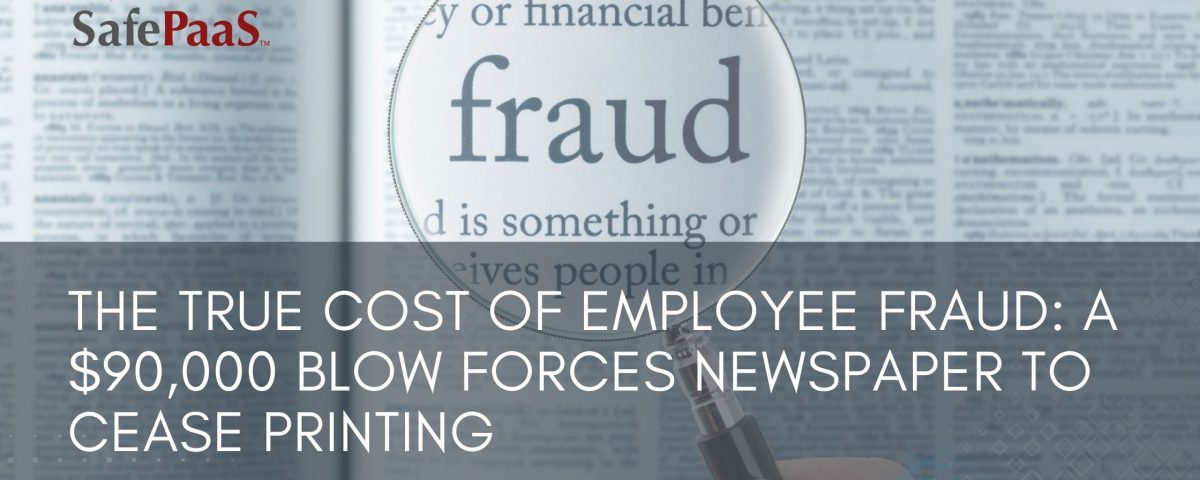The True Cost of Employee Fraud


The True Cost of Employee Fraud:
A $90,000 Blow Forces Newspaper to Cease Printing
In a shocking disclosure last week, the respected Eugene Weekly, a 40-year-old newspaper with a circulation exceeding 30,000, recently fell victim to a devastating case of embezzlement.
The New York Times reported that the newspaper's management uncovered a series of unpaid bills and unfunded retirement accounts totaling tens of thousands of dollars.
The cause? A former financial staffer allegedly stole $90,000 over five years, leading to significant financial turmoil and ultimately forcing the publication to halt its operations.
Take a Closer Look at Internal Controls
It is reported that the unnamed financial staffer entrusted with managing the newspaper's finances exploited their position by diverting funds into their personal accounts. The fraud went undetected until discrepancies emerged in the newspaper's financial records, revealing unauthorized transactions and financial mismanagement.
Reflecting on this, you realize that the Eugene Weekly incident is not an isolated case. Instances of employee fraud have been on the rise across all industries. Trusted employees with access to financial systems have abused their positions for personal gain, causing substantial financial losses.
The Power of Proactive Measures
Access governance and application controls are crucial in preventing and detecting fraud. In the case of Eugene Weekly, implementing these measures could have significantly mitigated the risk and potentially stopped the fraudulent activities.
Here's how access governance and controls could have been instrumental:
1. Segregation of Duties (SoD)
How it helps: Access governance enforces strict Segregation of Duties policies, ensuring that no single individual has unchecked control over financial processes.
By implementing role-based access controls, the financial staffer at Eugene Weekly would have been restricted from excessive control, making executing the fraudulent scheme without detection more challenging.
2. Regular Audits and Continuous Monitoring:
How it helps: Access governance tools include advanced monitoring features, allowing for continuous tracking of financial transactions.
Automated controls could have detected anomalies or unauthorized activities in real time, triggering alerts to management. Combined with automated tools, regular audits contribute to a proactive approach to identifying and addressing suspicious behavior.
3. External Reconciliation with Access Governance
How it helps: Access governance solutions extend beyond reconciliation by actively monitoring and managing user access to critical financial systems.
Engaging an independent party for external reconciliation, coupled with access governance, would provide an additional layer of oversight. Access governance tools could have flagged any unusual access patterns or changes in user privileges, raising red flags for further investigation.
4. Mandatory Vacations Enhanced with Access Governance
How it helps: Access governance adds an extra layer of security during employee absences by enforcing stringent controls on access to sensitive financial systems.
Requiring mandatory vacations for employees, especially those handling finances, would have forced cross-training among team members. Access governance tools ensure that even during the absence of a key individual, other team members have limited and monitored access, reducing the risk of undetected fraudulent activities.
5. Automated Remediation and Preventive Controls
How it helps: Access governance platforms often include automated remediation processes, streamlining response efforts during a security incident.
Automated controls could have expedited the resolution of security issues, reducing their impact. Preventive controls, enforced through access governance, would have proactively addressed security vulnerabilities, making it harder for the financial staffer to exploit weaknesses in the system.
6. User Access Reviews
How it helps: Access governance facilitates regular and systematic user access reviews, ensuring access privileges align with job roles and responsibilities.
Automated reviews within an access governance platform would have analyzed user access rights and activities within financial systems. This proactive approach could have quickly identified and addressed any irregularities or suspicious activities, contributing to the integrity of the financial systems.
Access governance and application financial controls provide a comprehensive and automated approach to managing access, monitoring activities, and responding to security incidents. By implementing these features, organizations can strengthen their financial controls, reduce the risk of fraud, and maintain a secure and compliant environment.
Moving Forward with Business's Integrity in Mind
Despite the financial setback, Eugene Weekly's leaders remain resilient in their commitment to the newspaper's mission. As you navigate your business, let this incident serve as a stark reminder for businesses of all sizes to prioritize internal controls, adopt preventive measures, and recognize the value of mandatory vacations enhanced with access governance in safeguarding against employee fraud.
Financial integrity is essential, and your proactive steps can make all the difference in preserving the trust and longevity of your organization.
Don't wait for fraud to strike – fortify your business against devastating financial losses with SafePaaS.
Recommended Resources

Segregation of Duties in Small Businesses
In small businesses, segregating duties poses a challenge because small businesses often operate with minimal staff, resulting in overlapping responsibilities among employees.

Security, segregation of duties and common examples
This blog explores common examples of departments and tasks that should be separated to ensure security. Finance and Accounting, IT, Human Resources...

Segregation of Duties Examples and Best Practices
Best Practices for Implementing Segregation of Duties include clear role definitions, regular review, automated controls, rotation of duties...

